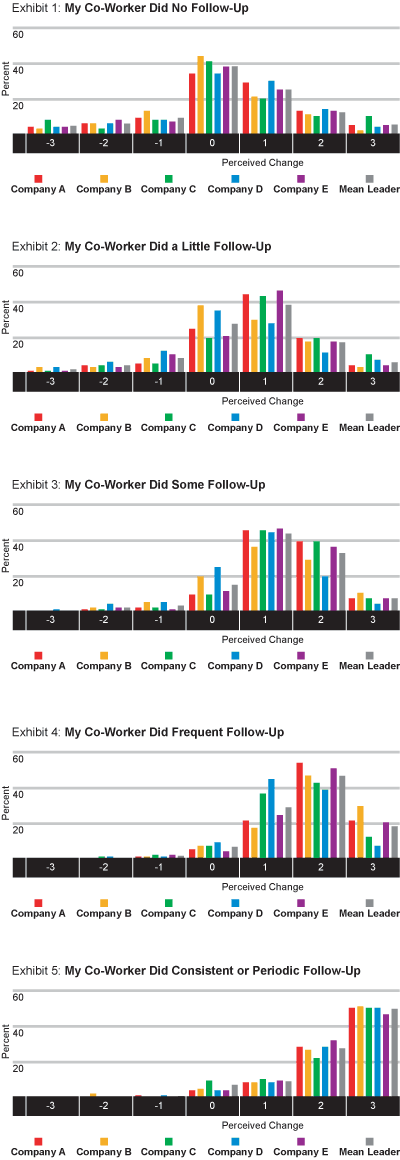Leadership Is a Contact Sport: The "Follow-up Factor" in Management Development
A review of leadership development programs at eight major corporations reveals that nothing works better than interaction with colleagues.
 |
|
Photograph by Robert Goldstrom
|
Organizational experts Paul Hersey and Kenneth Blanchard have defined leadership as “working with and through others to achieve objectives.” Many companies are stepping up to the challenge of leadership development and their results are quite tangible. In Leading the Way: Three Truths from the Top Companies for Leaders (John Wiley & Sons, 2004), a study of the top 20 companies for leadership development, Marc Effron and Robert Gandossy show that companies that excel at developing leaders tend to achieve higher long-term profitability.
But it sometimes seems there are as many approaches to leadership development as there are leadership developers. One increasingly popular tool for developing leaders is executive coaching. Hay Group, a human resources consultancy, reported that half of 150 companies surveyed in 2002 said that they had increased their use of executive coaching, and 16 percent reported using coaches for the first time.
Yet even “executive coaching” is a broad category. In reviewing a spate of books on coaching last year, Des Dearlove and Stuart Crainer identified at least three types of coaching: behavioral change coaching, personal productivity coaching, and “energy coaching.” (See “My Coach and I,” s+b, Summer 2003.) Our own upcoming book, The Art and Practice of Leadership Coaching: 50 Top Executive Coaches Reveal Their Secrets (written with Phil Harkins, to be published by John Wiley & Sons in December 2004), includes discussions about five types of leadership coaching: strategic, organizational change/execution, leadership development, personal/life planning, and behavioral.
Given the increasingly competitive economic environment and the significant human and financial capital expended on leadership development, it is not only fair but necessary for those charged with running companies to ask, “Does any of this work? And if so, how?” What type of developmental activities will have the greatest impact on increasing executives’ effectiveness? How can leaders achieve positive long-term changes in behavior? With admitted self-interest — our work was described in the Crainer–Dearlove article, and is frequently cited in reviews of and articles about leadership coaching — we wanted to see if there were consistent principles of success underlying these different approaches to leadership development.
We reviewed leadership development programs in eight major corporations. Although all eight companies had the same overarching goals — to determine the desired behaviors for leaders in their organizations and to help leaders increase their effectiveness by better aligning actual practices with these desired behaviors — they used different leadership development methodologies: offsite training versus onsite coaching, short duration versus long duration, internal coaches versus external coaches, and traditional classroom-based training versus on-the-job interaction.
Rather than just evaluating “participant happiness” at the end of a program, each of the eight companies measured the participants’ perceived increase in leadership effectiveness over time. “Increased effectiveness” was not determined by the participants in the development effort; it was assessed by preselected co-workers and stakeholders.
Time and again, one variable emerged as central to the achievement of positive long-term change: the participants’ ongoing interaction and follow-up with colleagues. Leaders who discussed their own improvement priorities with their co-workers, and then regularly followed up with these co-workers, showed striking improvement. Leaders who did not have ongoing dialogue with colleagues showed improvement that barely exceeded random chance. This was true whether the leader had an external coach, an internal coach, or no coach. It was also true whether the participants went to a training program for five days, went for one day, or did not attend a training program at all.
The development of leaders, we have concluded, is a contact sport.
Eight Approaches
The eight companies whose leadership development programs we studied were drawn from our own roster of clients over the past 16 years. Although all are large corporations, each company is in a different sector and each faces very different competitive pressures.
Each company customized its leadership development approach to its specific needs. Five of the eight focused on the development of high-potential leaders, and between 73 and 354 participants were involved in their programs. The three other companies included almost all managers (above midlevel), and involved between 1,528 and 6,748 managers. The degree of international representation varied among organizations. At two companies, almost all of the participants were American. Non-U.S. executives made up almost half of the participants in one company’s program. The other five had varying levels of international participation.
Some of the companies used traditional classroom-based training in their development effort. In each of these companies, participants would attend an offsite program and receive instruction on what the desired characteristics were for leaders in their organizations, why these characteristics were important, and how participants might better align their own leadership behavior with the desired model. Some companies, by contrast, used continuing coaching, a methodology that did not necessarily involve offsite training, but did rely on regular interaction with a personal coach. Some companies used both offsite training and coaching.
Along with differences, there were commonalities among the programs. Each company had spent extensive time reviewing the challenges it believed its leaders would uniquely face as its business evolved. Each had developed a profile of desired leadership behaviors that had been approved by upper management. After ensuring that these desired leadership behaviors were aligned with the company vision and values, each company developed a 360-degree feedback process to help leaders understand the extent to which their own behavior (as perceived by co-workers) matched the desired behavior for leaders in the corporation. All eight placed a set of expectations upon participants. The developing leaders were expected to:
-
Review their 360-degree feedback with an internal or external consultant.
-
Identify one to three areas for improvement.
-
Discuss their areas for improvement with key co-workers.
-
Ask colleagues for suggestions on how to increase effectiveness in selected areas for change.
-
Follow up with co-workers to get ideas for improvement.
-
Have co-worker respondents complete a confidential custom-designed “mini-survey” three to 15 months after the start of their programs.
Each participant received mini-survey summary feedback from three to 16 co-workers. Colleagues were asked to rate the participants’ increased effectiveness in the specific selected behaviors as well as participants’ overall increase (or decrease) in leadership effectiveness. Co-workers were also asked to measure the degree of follow-up they had with the participant. In total, we collected more than 86,000 mini-survey responses for the 11,480 managers who participated in leadership development activities. This huge database gave us the opportunity to explore the points of commonality and distinction among these eight very different leadership development efforts.
Three of the organizations permitted their names to be used in articles or conference presentations, enabling us to reference them in this report; the rest have requested anonymity, although we are able to describe their sector and activities. Two of the organizations also have allowed their results to be published elsewhere, without disclosure of the organization’s name. The companies whose programs we studied were:
• An aerospace/defense contractor: 1,528 managers (ranging from midlevel to the CEO and his team) received training for two and a half days. Each person reviewed his or her 360-degree feedback in person with an outside consultant. All received at least three reminder notes to help ensure that they would follow up with their co-workers.
• A financial-services organization: At GE Capital, 178 high-potential managers received training that lasted five days. Each leader was assigned a personal human resources coach from inside the company. Each coach had one-on-one sessions with his or her client on an ongoing basis (either in person or by phone).
• An electronics manufacturer: 258 upper-level managers received in-person coaching from an external coach. They did not attend an offsite training program. They were then each assigned an internal coach who had been trained in effective coaching skills. This coach followed up with the managers every three to four months.
• A diversified services company: 6,748 managers (ranging from midlevel to the CEO and his team) received one-on-one feedback from an external coach during two training programs, each two and a half days long, which were conducted 15 months apart. Although there was no formal follow-up provided by the coach, participants knew they were going to be measured on their follow-up efforts.
• A media company: 354 managers (including the CEO and his team) received one-on-one coaching and feedback during a one-day program. An external coach provided follow-up coaching every three to four months.
• A telecommunications company: 281 managers (including the CEO and his team) received training for one day. Each leader was given an external coach, who had continuing one-on-one sessions with his or her client.
• A pharmaceutical/health-care organization: Johnson & Johnson involved 2,060 executives and managers, starting with the CEO and his team, in one and a half days of leadership training. Each person reviewed his or her initial 360-degree feedback with an outside consultant (almost all by phone). Participants received at least three reminder notes to help ensure that they would follow up with their co-workers.
• A high-tech manufacturing company: At Agilent Technologies Inc., 73 high-potential leaders received coaching for one year from an external coach, an effort unconnected to any training program. Each coach had one-on-one sessions with his or her client on an ongoing basis, either in person or by phone.
Personal Touch
The overarching conclusion distilled from the surveys in all the programs was that personal contact mattered — and mattered greatly.
Five of the corporations used the same measurement methodologies, while three used a slightly different approach. All eight companies measured the frequency of managers’ discussions and follow-up with co-workers and compared this measure with the perceived increase in leadership effectiveness, as judged by co-workers in the mini-surveys. The first five firms — the aerospace/defense contractor, GE Capital, the electronics manufacturer, the diversified services company, and the media company — used a seven-point scale, from –3 to +3, to measure perceived change in leadership effectiveness, and a ½ve-point scale to plot the amount of follow-up, ranging from a low of “no follow-up” to a high of “consistent or periodic follow-up.” They then compared the two sets of measurements by plotting the effectiveness scores and the follow-up tallies on charts.
The remaining three firms used slightly different measurement criteria. The telecommunications company used a “percentage improvement” scale to measure perceived increases in leadership effectiveness, as judged by co-workers. It then compared “percentage improvement” on leadership effectiveness with each level of follow-up. Johnson & Johnson and Agilent measured leadership improvement using the same seven-point scale employed by the first five companies, but they did not categorize the degree of follow-up beyond the simple “followed up” vs. “did not follow up.”
As noted earlier, follow-up here refers to efforts that leaders make to solicit continuing and updated ideas for improvement from their co-workers. In the two companies that compared “followed up” with “did not follow up,” participants who followed up were viewed by their colleagues as far more effective than the leaders who did not. In the companies that measured the degree of follow-up, leaders who had “frequent” or “periodic/consistent” interaction with co-workers were reliably seen as having improved their effectiveness far more than leaders who had “little” or “no” interaction with co-workers.
Exhibits 1 to 5, below, show the results among the first five companies, which, despite their different leadership development programs, used the same measurement methodology. This apples-to-apples comparison shows strong correlations across all five companies between the degree of follow-up and the perceived change in leadership effectiveness.
In the exhibits, “perceived change” refers to the respondents’ perception of their co-worker’s change in leadership effectiveness; for example, a rating of “+3” would indicate that the co-worker was seen as becoming a much more effective leader; a rating of “0” would indicate no change in leadership effectiveness. “Percent” refers to the percentage of survey respondents grouped around a given rating; for example, in Exhibit 1, between 30 and 42 percent of respondents gave a “0” rating — that is, they saw no change — to leaders who “did no follow-up.”
Leadership, it’s clear from this research, is a relationship. And the most important participants in this relationship are not the coach and the “coachee.” They are the leader and the colleague.
Most of the leaders in this study work in knowledge environments — in companies where the value of the product or service derives less and less from manufacturing scale and, to use Peter Drucker’s formulation, more and more from the processing and creation of information to define and solve problems. In discussing leadership with knowledge workers, Professor Drucker has said, “The leader of the past was a person who knew how to tell. The leader of the future will be a person who knows how to ask.” Our studies show that leaders who regularly ask for input are seen as increasing in effectiveness. Leaders who don’t follow up are not necessarily bad leaders; they are just not seen as getting better.
Ask and Receive
In a way, our work reinforces a key learning from the Hawthorne studies. These classic observations of factory workers at suburban Chicago’s Western Electric Hawthorne Works, which Harvard professor Elton Mayo made nearly 80 years ago, showed that productivity tended to increase when workers perceived leadership interest and involvement in their work, as evidenced by purposeful change in the workplace environment. Our studies show that when co-workers are involved in leadership development, the leaders they are helping tend to become more effective. Leaders who ask for input and then follow up to see if progress is being made are seen as people who care. Co-workers might well infer that leaders who don’t respond to feedback must not care very much.
Historically, a great deal of leadership development has focused on the importance of an event. This event could be a training program, a motivational speech, or an offsite executive meeting. The experience of the eight companies we studied indicates that real leadership development involves a process that occurs over time, not an inspiration or transformation that occurs in a meeting.
Physical exercise provides a useful analogy. Imagine having out-of-shape people sit in a room and listen to a speech on the importance of exercising, then watch some tapes on how to exercise, and perhaps practice exercising. Would you ever wonder why these people were still unfit a year later? The source of physical fitness is not understanding the theory of working out; it is engaging in exercise. As Arnold Schwarzenegger has said, “Nobody ever got muscles by watching me work out!” So, too, with leadership development. As Professor Drucker, Dr. Hersey, and Dr. Blanchard have pointed out, leadership involves a reliance on other co-workers to achieve objectives. Who better than these same co-workers to help the leader increase effectiveness?
Indeed, the executive coach is, in many ways, like a personal trainer. The trainer’s role is to “remind” the person being trained to do what he or she knows should be done. Good personal trainers spend far more time on execution than on theory. The same seems to be true for leadership development. Most leaders already know what to do. They have read the same books and listened to the same gurus giving the same speeches. Hence, our core conclusion from this research: For most leaders, the great challenge is not understanding the practice of leadership: It is practicing their understanding of leadership.
Beyond the basic finding — that follow-up matters — several other conclusions arise from our research. For example, the eight-program study indicates that the follow-up factor correlates with improved leadership effectiveness among both U.S. and non-U.S. executives.
As companies globalize, many executives have begun to wrestle with issues of cultural differences among their executives and employees. Recent research involving high-potential leaders from around the world has shown that cross-cultural understanding is seen as a key to effectiveness for the global leader. (See, for example, Marshall Goldsmith et al., Global Leadership: The Next Generation, Financial Times Prentice Hall, 2003.)
Our study addressed this issue as it affects leadership development programs. Nearly 10,000 of the respondents in the eight companies whose programs we reviewed — almost 12 percent of our mini-survey sample — were located outside the United States. We found that the degree of follow-up was as critical to changing perceived leadership effectiveness internationally as it was domestically. This was true for both training and coaching initiatives.
At Johnson & Johnson, there were almost no differences in scores among participants in Europe, Latin America, and North America. The group seen as improving the most was in Asia. In analyzing the findings, J&J determined that the higher scores in Asia were more a function of dedicated local management than of cultural differences, again supporting the correlation between a caring, contact-rich leadership and its perceived effectiveness.
That follow-up works globally contravenes assumptions that different cultures will have differing levels of receptiveness to intimate conversations about workplace behaviors. But the universality of the follow-up principle doesn’t imply universality in its application. Leaders learn from the people in their own environment, particularly in a cross-cultural context. Indeed, research by the Center for Creative Leadership in Greensboro, N.C., has shown that “encouraging feedback” and “learning from those around us” are both central to success for leaders in cross-cultural environments. Companies with successful leadership development programs encourage executives to adapt the universal principle of follow-up and the frequency of such conversations to fit the unique requirements of the culture in which they working. Despite other cultural differences, there seems to be no country in the world where co-workers think, “I love it when you ask me for my feedback and then ignore me.”
Inside and Outside
Interaction between the developing leader and his or her colleagues is not the sole connection that counts. Also vital is the contact between the leader and the coach. Our third major finding concerns that relationship: Both internal and external coaches can make a positive difference.
One reason coaching can be so effective is that it may inspire leaders to follow up with their people. Agilent Technologies, for one, found a strong positive correlation between the number of times the coach followed up with the client and the number of times the client followed up with co-workers.
The coach, however, does not have to be part of the company. This conclusion was readily apparent when we compared the two companies most distinct in the composition of their coaching corps. Agilent used only external coaches. GE Capital, by contrast, used only internal coaches from human resources. Yet both approaches produced very positive long-term increases in perceived leadership effectiveness.
Given the apparent ease of accessibility to internal coaches, firms might naturally use this finding to justify “going inside.” But there are at least three important variables to consider in determining whether to use an internal HR coach: time, credibility, and confidentiality.
In many organizations, internal coaches are not given the time they need for ongoing interaction with the people they are coaching. In some cases, they may not seem as credible as trained development experts. In other cases, especially those that involve human resources personnel filling multiple roles, there may appear to be a conflict of interest between a professional’s responsibilities as coach and as evaluator. If these perceptions exist, then external coaches may well be preferable to internal coaches.
But internal coaches can overcome these obstacles. At GE Capital, the internal coaches were HR professionals who were given time to work with their “coachees.” Coaching was treated as an important part of their responsibility to the company and was not seen as an add-on “if they got around to it.” Moreover, the coachees were given a choice of internal coaches and picked coaches they saw as most credible. Finally, each internal coach worked with a leader in a different part of the business. They assured their coachees that this process was for high-potential development, not evaluation. As a result of this thorough screening process, client satisfaction with internal coaches was high and results achieved by internal coaches (as judged by co-workers) were very positive.
Inside or outside, we discovered that the mechanics of the coach–leader relationship were not a major limiting factor. Our fourth finding was that feedback or coaching by telephone works about as well as feedback or coaching in person.
Intuitively, one might believe that feedback or coaching is a very “personal” activity that is better done face-to-face than by phone. However, the companies we reviewed do not support this supposition. One company, Johnson & Johnson, conducted almost all feedback by telephone, yet produced “increased effectiveness” scores almost identical to those of the aerospace/defense organization, which conducted all feedback in person.
Moreover, all the companies that used only external coaches similarly found little difference between telephone coaching and live coaching. These companies made sure that each coach had at least two one-on-one meetings with individual executive clients. Some coaches did this in person, whereas others interacted mostly by phone. There was no clear indication that either method of coaching was more effective than the other.
Although sophisticated systems — involving some combination of e-mail, intranets, extranets, and mobile connectivity — are available, follow-up needn’t be expensive. Internal coaches can make follow-up telephone calls. New computerized systems can send “reminder notes” and give ongoing suggestions. However it’s done, follow-up is the sine qua non of effective leadership development. Too many companies spend millions of dollars for the “program of the year” but almost nothing on follow-up and reinforcement.
Companies should also take care to measure the effectiveness of their leadership development initiatives, and not just the employees’ satisfaction with them. Our results indicate that when participants know that surveys or other methods of measuring program effectiveness are slated to occur three to 15 months from the date of the program, a higher level of commitment is created among them. This follow-up measurement creates a focus on long-term change and personal accountability.
Although measuring outcomes would seem to be second nature for most companies, the success of leadership development programs has conventionally been assessed through the satisfaction of the participants. This metric is of limited relevance. Among the companies in our study that offered leadership development training, virtually all participants came away highly satisfied. At the aerospace/defense contractor and Johnson & Johnson, the average satisfaction rating among more than 3,500 participants was 4.7 out of a possible 5.0. Executives loved the training, but that didn’t mean they used the training or improved because of it.
Learning to Learn
Of even greater import is this: Continual contact with colleagues regarding development issues is so effective it can succeed even without a large, formal program. Agilent, for example, produced excellent results, even though its leaders received coaching that was completely disconnected from any training. In fact, leaders who do not have coaches can be coached broadly by their co-workers. The key to changing behavior is “learning to learn” from those around us, and then modifying our behavior on the basis of their suggestions. The aerospace/defense contractor and the telecommunications company used very streamlined and efficient training processes and “reminder notes” to help leaders achieve a positive long-term change in effectiveness, without using coaches at all.
If the organization can teach the leader to reach out to co-workers, to listen and learn, and to focus on continuous development, both the leader and the organization will benefit. After all, by following up with colleagues, a leader demonstrates a commitment to self-improvement — and a determination to get better. This process does not have to take a lot of time or money. There’s something far more valuable: contact.![]()
Reprint No. 04307
Marshall Goldsmith (marshall@marshallgoldsmith.com) is a founder of Marshall Goldsmith Partners, a leadership coaching network. He has worked with more than 70 major CEOs and their management teams and is the author or coauthor of 18 books on leadership and coaching. His most recent book is Global Leadership: The Next Generation (Financial Times Prentice Hall, 2003).
Howard Morgan (howard@howardjmorgan.com) is the founder of 50 Top Coaches, a collective of many of the world’s leading executive advisors. He specializes in executive coaching as a strategic change-management tool. He is co-editor of the forthcoming book The Art and Practice of Leadership Coaching: 50 Top Executive Coaches Reveal Their Secrets (John Wiley & Sons, December 2004).





